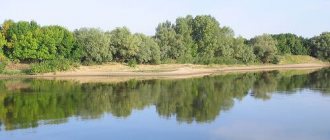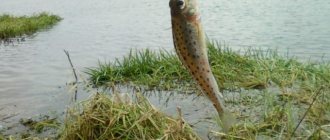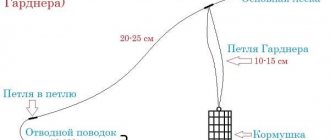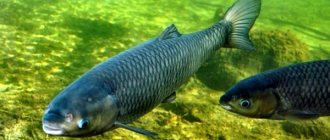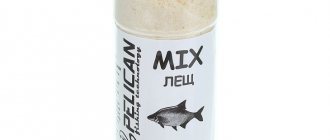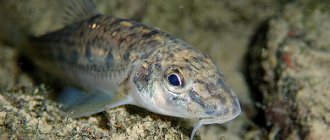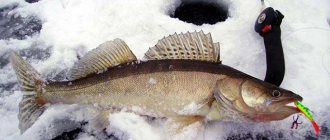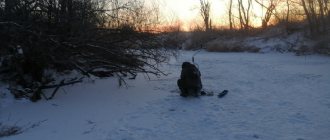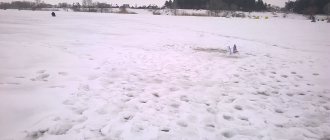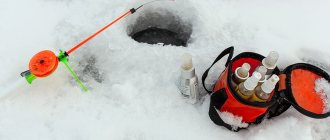The Atuba River flows in the Astrakhan region and is the left branch of the Volga. The length of the river is 537 kilometers, the bed is quite wide 200-300 meters, the current is moderate. Fishing on Akhtuba is very promising; there is a lot of fish here, including large catfish and carp.
| Name: | Akhtuba |
| Length: | 537 km |
| Fish: | bream, pike, perch, pike perch, roach, crucian carp, carp, catfish, asp |
| Mouth: | Buzan |
| Region: | Astrakhan |
In the Astrakhan region, the main river is the Volga, which has a sufficient number of branches here. So here is the Akhtuba River, one of these branches, and in fact the largest. Together they form a river valley, the largest in Europe, the so-called Volga-Akhtuba floodplain. The width of the floodplain reaches 28 km, and it is cut by a large number of large and small branches. duct. 90% of the floodplain is in the Astrakhan region, the rest in the Volgograd region.
The bed of the Akhtuba River is very winding; it periodically communicates with the Volga along its entire length through channels and eriks. The depth of Akhtuba ranges from 2 to 12 meters, although there are holes up to 20 meters deep. Such a diverse channel system is perfect for many types of fish, making fishing here especially interesting.
Fish biting forecast on Akhtuba
| Weather forecast and fish bite | Akhtuba, from 02/16/2021 to 02/19/2021 | |||||||||||
| VT | SR | Thu | PT | |||||||||
| Times of Day | Evening | Night | Morning | Day | Evening | Night | Morning | Day | Evening | Night | Morning | Day |
| Cloudiness, precipitation | Mainly cloudy | Mainly cloudy | Mainly cloudy | Mainly cloudy | Mainly cloudy | Mainly cloudy | Mainly cloudy | Mainly cloudy | Partly cloudy | Partly cloudy | Partly cloudy | Mainly cloudy |
| Temperature °C | -7 | -8 | -10 | -11 | -7 | -10 | -12 | -11 | -6 | -7 | -7 | -6 |
| Pressure, mm. | 768 | 768 | 767 | 765 | 764 | 764 | 764 | 765 | 765 | 766 | 767 | 768 |
| Direction, | Wind northeast | Wind northeast | Wind northeast | Wind northeast | Wind northeast | North wind | North wind | North wind | Wind northwest | East wind | South wind | South wind |
| wind speed | 5 m/s | 5 m/s | 5 m/s | 6 m/s | 6 m/s | 6 m/s | 4 m/s | 2 m/s | 2 m/s | 1 m/s | 2 m/s | 2 m/s |
| According to the forecast, they will bite on: bloodworms crucian carp | 30% | 0% | 40% | 40% | 30% | 0% | 40% | 40% | 50% | 0% | 60% | 55% |
| According to the forecast it doesn't bite Carp | 0% | 0% | 0% | 0% | 0% | 0% | 0% | 0% | 0% | 0% | 0% | 0% |
| According to the forecast, the fish will bite on: live bait (jigs), winter spinners, balancers Pike | 50% | 10% | 60% | 60% | 50% | 10% | 60% | 60% | 50% | 0% | 60% | 75% |
| According to the forecast, they will bite on: bloodworms, winter spoons, balance beams Perch | 40% | 0% | 50% | 50% | 40% | 0% | 50% | 50% | 60% | 0% | 70% | 65% |
| According to the forecast, the fish will bite on: live bait, winter spinners, balancer Zander | 40% | 40% | 50% | 30% | 40% | 40% | 50% | 30% | 60% | 45% | 70% | 45% |
| According to the forecast, the fish will bite on: bloodworms, oparish, small spoons Chekhon | 25% | 0% | 35% | 35% | 25% | 0% | 35% | 35% | 50% | 0% | 60% | 50% |
| According to the forecast, they will bite on: bloodworms, maggots, bark beetles, burdocks Dace | 25% | 20% | 35% | 35% | 25% | 20% | 35% | 35% | 50% | 30% | 60% | 50% |
| According to the forecast, they will bite on: bloodworms, maggots, bark beetles, burdocks Ruff | 25% | 20% | 35% | 30% | 25% | 20% | 35% | 30% | 50% | 30% | 60% | 45% |
| According to the forecast, they will bite on: bloodworms, maggots, bark beetles, burdocks Chub | 20% | 0% | 40% | 25% | 20% | 0% | 40% | 25% | 50% | 10% | 70% | 45% |
| Doesn't bite Asp | 0% | 0% | 10% | 0% | 0% | 0% | 10% | 0% | 30% | 0% | 40% | 10% |
| Bait: maggot, bloodworm Bream | 20% | 35% | 30% | 20% | 20% | 35% | 30% | 20% | 50% | 45% | 60% | 40% |
| Bait: worm, live bait, spinner Burbot | 60% | 70% | 60% | 30% | 60% | 70% | 60% | 30% | 60% | 50% | 60% | 50% |
| Bait: maggot, bloodworm Roach | 40% | 0% | 60% | 50% | 40% | 0% | 60% | 50% | 50% | 0% | 70% | 65% |
| Bait: maggot, bloodworm Bleak | 30% | 0% | 40% | 40% | 30% | 0% | 40% | 40% | 50% | 0% | 60% | 50% |
| Bait: maggot, bloodworm, bark beetle Ide | 10% | 0% | 20% | 10% | 10% | 0% | 20% | 10% | 40% | 0% | 50% | 30% |
| Bait: no Som | 0% | 0% | 0% | 0% | 0% | 0% | 0% | 0% | 0% | 0% | 0% | 0% |
Recipe for making fish soup from bream
You will need: 0.5 kg of large bream meat, 200 g of sauerkraut, 200 g of potatoes, 2 tablespoons of tomato (can be replaced with tomatoes), 2 tablespoons of vegetable oil, 50 g of sour cream, approximately 1.5-2 liters of water, large onion, 1 parsley root (celery, parsnip), 1 tablespoon flour, 1 bay leaf, 1 dill umbrella, black peppercorns, salt, herbs. Place the gutted fish, cleared of scales and gills, into boiling water with salt and cook for 20-25 minutes. Then remove the fish and strain the broth, cut the fish into portions. Place the washed and squeezed sauerkraut into the boiling broth and cook for another 20 - 25 minutes, then add the potatoes cut into cubes and cook for another 10 minutes. At the same time, chop the onion and parsley root and fry them in vegetable oil until golden brown, then add the tomato or peeled tomatoes and simmer for 3 - 4 minutes over low heat. Place the fried vegetables, bay and dill in the cabbage soup and cook the cabbage soup for another 3 minutes. Fry the flour in vegetable oil until golden brown and add to the cabbage soup along with the fish pieces. Add bay leaf to the cabbage soup, pepper and cook for another 2 minutes. If desired, you can add a couple of cloves of finely chopped garlic at the last moment. Ready! Serve cabbage soup at the table, placing sour cream, chopped herbs and mustard on the tip of a knife in each plate.
More
Fishing on Akhtuba in spring
Fishing on Akhtuba in spring is no less in demand than at other times of the year. The climate here is relatively warm, frosts occur only in March, but during the day the temperature has time to warm up. Spring fishing on Akhtuba is comfortable due to the absence of insects, the bites of which some people are allergic to. In April and May, air temperatures can already reach up to +30 degrees. And having sunscreen will not be superfluous; in the spring sun you get a tan very well. A buff, baseball cap and sunglasses will not be superfluous elements of equipment.
You can fish on Akhtuba in the spring with a variety of gear. Spinning fishing is especially interesting here, asp, pike perch, perch, pike. These are the fish that spinning anglers should pay attention to. In the spring, you need to look for the asp along the current; it may approach the riffles, or stand in the water column on holes. But the presence of a current is mandatory. In the spring, pike perch will stick to deep places and riverbed edges. Its accumulations in such places can be quite large. Perch will stick to shallower sections of the river, right down to the shore. Prefers areas with a hard bottom and shell rock. In the spring, pike will bite well in early March, before spawning. Then its nibble will resume in mid-April, and closer to May, post-spawning feeding is possible.
In spring, roach is caught well on bottom and float rods on Akhtuba. Which, when dried, has excellent taste and goes well with beer.
Where and when to catch bream on Akhtuba?
The favorite habitats of bream are areas with warm, calm water and a bottom covered with sand or silt. That is why fish are most often found in river bays, flowing lakes and ilmen. The most productive fishing for bream is deep, but you should avoid areas with a smooth sandy bottom and fast currents. Smaller specimens try to stay closer to the shore.
In spring and early summer, bream gather in schools. For a large catch, you should focus on deep-sea places overgrown with aquatic plants. The most intense bite is observed in the morning and evening, but you can also go out for water hunting at noon. During the day, the fish is cautious and not very rarely approaches the coastal zone in order to feed.
Fishing on Akhtuba in summer
Summer fishing on the Akhtuba River attracts a huge number of both avid fishermen and lovers of outdoor recreation when fishing is not the main thing. Therefore, there are many promising places, and fishing bases here are constantly busy. So you need to prepare for summer fishing in the spring. The air temperature in summer on Akhtuba can rise to +40. The weather here is mostly sunny and it rains infrequently.
In summer, in addition to excellent spinning fishing, carp are well caught using bottom gear. And many fishermen go here specifically for this large and strong fish of the carp family. Carp should be caught on bottom gear where the bait is makuh, corn, boiled potatoes or modern boilies. You need to look for carp on a sandy bottom, near holes. This fish likes to rest in pits, but goes to shallower areas of the reservoir to feed.
Catfish is another fish that you should try to catch on Akhtuba in the summer. Here he is often found weighing more than 20 kilograms. You can catch catfish from a boat using a quok. To do this, they go on a fine sunny day to the deep-water sections of the river, and patiently croak until dusk. The bait in these places is catfish, live bait, a bunch of crawlers, a frog, clams, or a sandwich (when different baits are attached to one hook at the same time).
Those who fish from the shore can successfully catch catfish using bottom rods. It bites best at night, the bait is the same as when fishing with quok. It is better to throw donks at the exits from the pits, and to the approaches to shallow water, where the catfish will leave the pits for hunting.
Description of the species, lifestyle of bream
Bream (lat. Abramis brama), a real “talk of the town” for Russian fishing, is a fish of the carp family and the only representative of the bream genus. Perhaps one of the most popular and famous fish in Russian culture and Russian cuisine since ancient times. In Russian folklore it is mentioned no less often than pike and crucian carp. Bream has a characteristic, very wide, laterally flattened body. The color of its scales ranges from almost white-silver to bronze-black, varying depending on habitat conditions. The back is almost black.
Bream is very widespread in almost all regions of Russia and Europe. Bream lives in reservoirs, lakes, ponds and rivers. Bream is especially numerous at the mouths of large rivers, where it gathers in huge numbers in the second half of summer. In the fall, some of the fish again enter up the rivers and choose deep holes there before wintering or, sometimes, the slightest depressions in the bottom in backwaters, and stand there for the winter. In the middle and upper reaches of rivers, bream spend the winter in deep places in bays and flowing lakes, and their autumn movement, as happens in the Lower Volga, is not observed. This is a pronounced schooling fish and its schools can be very numerous; in the lower reaches of large rivers, by autumn, bream can gather in groups of up to tens of thousands of individuals.
The average size of Akhtuba bream is 30-50 centimeters, weighing 2-3 kg, but giants up to 70 cm long and weighing 5-6 kg are often encountered.
Like most carp fish, bream feeds on mollusks, worms, insect larvae and small crustaceans, that is, it prefers animal food. It also feeds in large groups, methodically combing and digging up the muddy bottom.
On Akhtuba, in the area of the fishing village of Trekhrechye, bream spawning occurs in the spring. It spawns on grassy shallows, in shallow bays, and sometimes also in pools flooded by floods.
Fishing on Akhtuba in autumn
Autumn fishing is more comfortable than in summer, especially the first two months of autumn. The air temperature will drop, it will no longer be hot, but not yet cold. And the water temperature will gradually but slowly begin to cool, giving a signal to the fish that they need to start actively feeding. In autumn, rains fall here regularly, although not for long periods. During the day the air temperature can rise to +25, in the evening up to +4 +7. But in October, the first frosts are already possible, after which pike and pike perch will begin to eat.
In September, it is best to catch carp on Akhtuba using bottom rods; at this time, it begins to eat. Bream will also be actively biting. You can successfully catch jerch and perch using a spinning rod. Pike and pike perch will bite more actively after the first frost, usually from the second half of October until mid-November.
Fishing on Akhtuba in winter
Winter fishing on Akhtuba is no less interesting than at other times of the year, but requires more carefully thought out equipment. It is interesting that the main channel of the river does not freeze in winter, this is clearly noticeable in recent years. So fans of winter spinning will find what and where to fish here.
For those who associate winter fishing with ice. You need to go to the channels and eriks that connect Akhtuba with the Volga. The flow on the channels is slower, and the width of the channel is small. So this contributes to the freezing of water, and closer to the new year the ice on such channels is suitable for winter fishing. Although if winter comes early and with frosts, then you can already count on all three months of ice fishing.
In winter, perch and roach can be caught well from the ice using a jig; if you know the places, you can also catch good bream. But of course we shouldn’t forget about the pike. It is caught here primarily with girders; roach in these places is a very good live bait. The vents can be installed during the day, or, if possible, installed at night. And check it in the morning.
If you decide to come for winter fishing for a few days, then you need to stay either in the nearest hotel, or at a fishing base, in a private house. Next there will be a list of fishing bases and hotels located on the Akhtuba River.
Fishing bases on Akhtuba
If you decide to visit this beautiful and fish-filled river for a few days. You can stay in a hotel, lodge or fishing base. There are a sufficient number of them in these places. Then fishing will be more enjoyable and you will have the opportunity to get a good night's sleep. It’s no secret that this activity is quite exhausting, especially spinning fishing. After a whole day spent on the water with a spinning rod. In the evening I feel very physical fatigue. Although the mood will certainly be good. The following is a list of fishing bases and hotels on Akhtuba:
“Golden Plav” - Kharabali district, 30 km south-southeast of the city of Kharabali. The base is located on the territory of the Kharabalinskoye hunting estate. At the confluence of three rivers: Akhtuba, Ashuluk and Kriushi.
“Sandy Beach” - the base is located in the surroundings of a large forest, hidden from the steppe winds. The Volga-Akhtuba floodplain, on the left bank of the Ashuluk erik, at the confluence of the Akhtuba river and the Ashuluk erik.
“Fisherman's Wharf” - access to the base is available all year round - both during high water and during spring thaw. The road has been improved for passenger cars. There are no tracks. The base territory stretches 700 meters along the coastline and is surrounded by deciduous forest.
“Razdolye” - on the right bank of Akhtuba at the confluence of Shekardyk Bay and the Poselskaya and Akhtuba rivers, next to a vast ten-meter hole. There are many bodies of water around: rivers, lakes, eriks, rich in a variety of fish.
“Fish Land” - on the border of the Chapuriy and Sazaniy Ugol tracts, 20 km above the city of Kharabali. In the Volga-Akhtuba floodplain, on the left bank of the Akhtuba River, fishing in the Volga-Akhtuba floodplain on the Akhtuba, Volga, Ashuluk rivers.
“Fishing Village” - the entire road from the Volgograd-Astrakhan highway to the base is asphalted. On the banks of the Enotaevka River, which is replete with vast reaches, holes, and sand spits.
“Fisherman’s Estate” - On the right bank of the Volga River in the Volga-Akhtuba floodplain, in the Srednyaya Akhtuba area. Near the base there are famous fishing spots - the Akhtuba River, the Koktsikmen, Bukovsky, and Parashkina channels.
"Avalon" - on the left bank of the Volga River at the mouth of the Erik Nasedkin. Fishing is carried out in the Lower Volga, Mitinka, Akhtuba. 100 meters from the base there are catfish pits.
“Word Fish” is the Volga-Akhtuba floodplain, at the confluence of the Akhtuba, Ashuluk and Kriusha (Mangut) rivers, the so-called “Lower Three Rivers”. Fishing from the shore in the vicinity of the base is possible, because... The bank of the Ashuluk River near the base is flat, so there will be no problems with shore fishing.
If you know more detailed information about this body of water, leave reviews and fishing reports in the comments.
